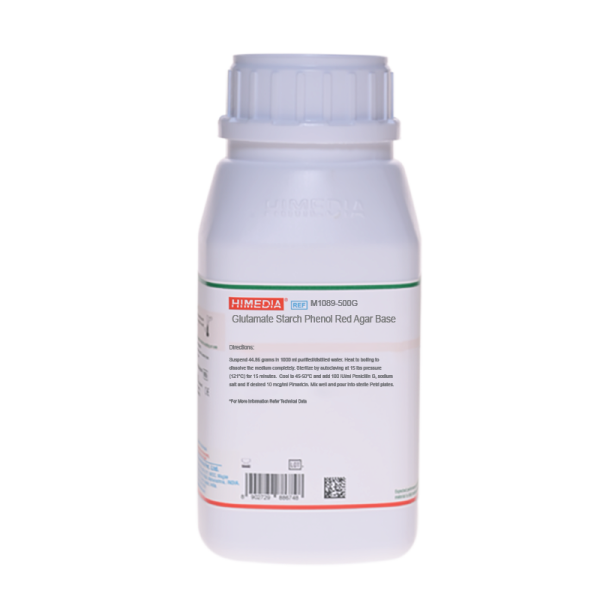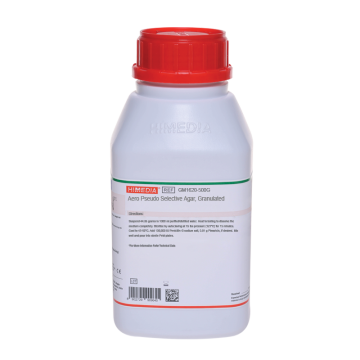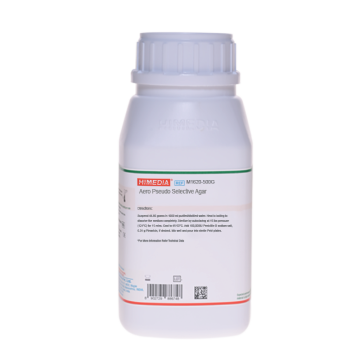 Your enquiry has been submitted
Your enquiry has been submitted
Glutamate Starch Phenol Red Agar Base
Aeromonas hydrophila#CC293D
Intended Use
Recommended for detection of Pseudomonas and Aeromonas species in foodstuffs and wastewater and equipments in food industry.
Composition**
| Ingredients | Gms / Litre |
|---|---|
| L-Glutamate, sodium | 10.000 |
| Starch, soluble | 20.000 |
| Potassium dihydrogen phosphate | 2.000 |
| Magnesium sulphate | 0.500 |
| Phenol red | 0.360 |
| Agar | 12.000 |
Final pH (at 25°C): 7.2±0.2
**Formula adjusted, standardized to suit performance parameters
Directions
Suspend 44.86 grams in 1000 ml purified/distilled water. Heat to boiling to dissolve the medium completely. Sterilize by autoclaving at 15 lbs pressure (121°C) for 15 minutes. Cool to 45-50°C and add 100 IU/ml Penicillin G, sodium salt and if desired 10 mcg/ml Pimaricin. Mix well and pour into sterile Petri plates.
Principle And Interpretation
Aeromonas commonly contaminate fish and related seafood products since they occur widely in aquatic environment. Motile aeromonads have also been associated with refrigerated animal products such as chicken, beef, pork etc (2,3,6). The predominant organisms found in these foods are Pseudomonas species with the motile aeromonads present in low numbers (9). Glutamate Starch Phenol Red Agar Base is used for the detection of Pseudomonas and Aeromonas species in foodstuffs, waste water and equipment in the food industry. This medium is a modification of Korths Medium (8), as described by Keilwein (7).
Glutamate Starch Phenol Red Agar Base is based on the ability of Aeromonas to utilize starch with the subsequent production of acid, detected the pH indicator i.e. phenol red. Phenol red changes from red to yellow colour under acidic conditions. Pseudomonas does not utilize starch and therefore does not form yellow colonies. The medium is designed to support the growth of both Pseudomonas and Aeromonas species.
L-glutamate is a source of essential nutrients. Starch is the source of carbon. Phosphate buffers the medium whereas magnesium sulphate is a source of essential ions. Antibiotics help to improve the selectivity of the medium. The medium may be surface inoculated or used in membrane filtration technique.
Type of specimen
Food samples; Water samples
Specimen Collection and Handling
For food samples, follow appropriate techniques for sample collection and processing as per guidelines (9). For water samples, follow appropriate techniques for sample collection, processing as per guidelines and local standards.(1) After use, contaminated materials must be sterilized by autoclaving before discarding.
Warning and Precautions :
Read the label before opening the container. Wear protective gloves/protective clothing/eye protection/ face protection. Follow good microbiological lab practices while handling specimens and culture. Standard precautions as per established guidelines should be followed while handling specimens. Safety guidelines may be referred in individual safety data sheets.
Limitations :
- Individual organisms differ in their growth requirement and may show variable growth patterns on the medium.
Performance and Evaluation
Performance of the medium is expected when used as per the direction on the label within theexpiry period when stored at recommended temperature.
Quality Control
Appearance: Light yellow to orange homogeneous free flowing powder
Gelling: Firm, comparable with 1.2% Agar gel.
Colour and Clarity of prepared medium: Red coloured, clear to slightly opalescent gel forms in Petri plates
Reaction: Reaction of 4.5% w/v aqueous solution at 25°C. pH: 7.2±0.2
pH: 7.00-7.40
Cultural Response
Cultural characteristics observed with added 100 IU Penicillin G, sodium salt and 10 mcg/ml Pimaricin after an incubation at 25-30°C for 48-72 hours.
| Organism | Inoculum (CFU) | Growth | Recovery | Starch hydrolysis |
|---|---|---|---|---|
| Aeromonas hydrophila ATCC 7966 (00063*) | 50-100 | good-luxuriant | >=50% | positive reaction, acid production, yellow colour |
| Pseudomonas aeruginosa ATCC 27853 (00025*) | 50-100 | good-luxuriant | >=50% | negative reaction, no acid production |
Key: *Corresponding WDCM numbers.
Storage and Shelf Life
Store between 10-30°C in a tightly closed container and the prepared medium at 2-8°C. Use before expiry date on the label. On opening, product should be properly stored dry, after tightly capping the bottle in order to prevent lump formation due to the hygroscopic nature of the product. Improper storage of the product may lead to lump formation. Store in dry ventilated area protected from extremes of temperature and sources of ignition. Seal the container tightly after use. Product performance is best if used within stated expiry period.
Disposal
User must ensure safe disposal by autoclaving and/or incineration of used or unusable preparations of this product. Follow established laboratory procedures in disposing of infectious materials and material that comes into contact with sample must be decontaminated and disposed of in accordance with current laboratory techniques (4,5).
Reference
- Baird R.B., Eaton A.D., and Rice E.W., (Eds.), 2015, Standard Methods for the Examination of Water and Wastewater, 23rd ed., APHA, Washington, D.C.
- Enfors S. O., Molin G. and Ternstrom A., 1979, J. Appl. Bacteriol., 47:1
- Hunter P. R. and Burge S. H., 1987, Appl. Microbiol., 4:
- Isenberg, H.D. Clinical Microbiology Procedures Handbook 2nd Editio
- Jorgensen, J.H., Pfaller, M.A., Carroll, K.C., Funke, G., Landry, M.L., Richter, S.S and Warnock., D.W. (2015) Manual of Clinical Microbiology, 11th Edition. Vol. 1.
- Kielwein G., Gerlach R. and Johne H., 1969, Areh Zebensmittelhyg., 20:
- Kielwein G., 1971, Arch. G. Lenensmillehyg. 22:29-
- Korth H., 1963, Zbl. Backt. Parasit. Hyg. Abt. 190:2
- Salfinger Y., and Tortorello M.L., 2015, Compendium of Methods for the Microbiological Examination of Foods, 5th Ed., American Public Health Association, Washington, D.C.
| Product Name | Glutamate Starch Phenol Red Agar Base |
|---|---|
| SKU | M1089 |
| Product Type | Regular |
| Physical Form | Powder |
| Origin | Animal Free (Veg) |
| Packaging type | HDPE |
| References | 1. Enfors S. O., Molin G. and Ternstrom A., 1979, J. Appl. Bacteriol., 47:197 |
| Customized Product Available | No |






